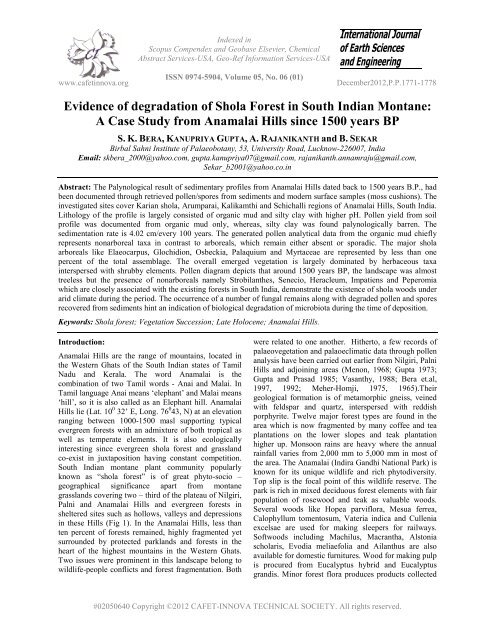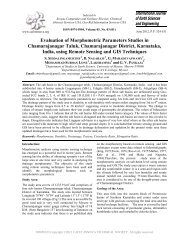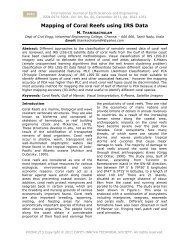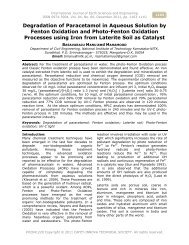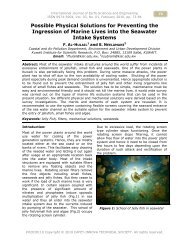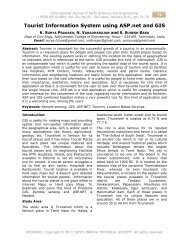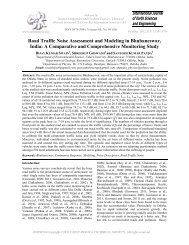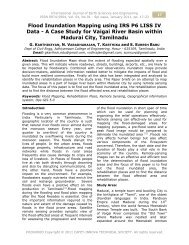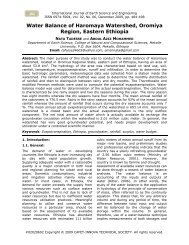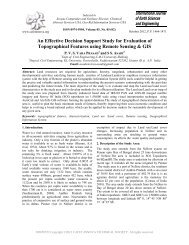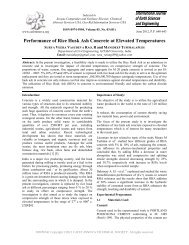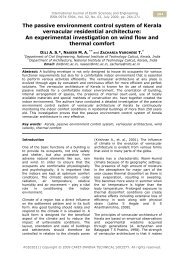A Case Study from Anamalai Hills since 1500 years BP - Cafet Innova
A Case Study from Anamalai Hills since 1500 years BP - Cafet Innova
A Case Study from Anamalai Hills since 1500 years BP - Cafet Innova
Create successful ePaper yourself
Turn your PDF publications into a flip-book with our unique Google optimized e-Paper software.
www.cafetinnova.org<br />
Indexed in<br />
Scopus Compendex and Geobase Elsevier, Chemical<br />
Abstract Services-USA, Geo-Ref Information Services-USA<br />
ISSN 0974-5904, Volume 05, No. 06 (01)<br />
December2012,P.P.1771-1778<br />
Evidence of degradation of Shola Forest in South Indian Montane:<br />
A <strong>Case</strong> <strong>Study</strong> <strong>from</strong> <strong>Anamalai</strong> <strong>Hills</strong> <strong>since</strong> <strong>1500</strong> <strong>years</strong> <strong>BP</strong><br />
S. K. BERA, KANUPRIYA GUPTA, A. RAJANIKANTH and B. SEKAR<br />
Birbal Sahni Institute of Palaeobotany, 53, University Road, Lucknow-226007, India<br />
Email: skbera_2000@yahoo.com, gupta.kanupriya07@gmail.com, rajanikanth.annamraju@gmail.com,<br />
Sekar_b2001@yahoo.co.in<br />
Abstract: The Palynological result of sedimentary profiles <strong>from</strong> <strong>Anamalai</strong> <strong>Hills</strong> dated back to <strong>1500</strong> <strong>years</strong> B.P., had<br />
been documented through retrieved pollen/spores <strong>from</strong> sediments and modern surface samples (moss cushions). The<br />
investigated sites cover Karian shola, Arumparai, Kalikamthi and Schichalli regions of <strong>Anamalai</strong> <strong>Hills</strong>, South India.<br />
Lithology of the profile is largely consisted of organic mud and silty clay with higher pH. Pollen yield <strong>from</strong> soil<br />
profile was documented <strong>from</strong> organic mud only, whereas, silty clay was found palynologically barren. The<br />
sedimentation rate is 4.02 cm/every 100 <strong>years</strong>. The generated pollen analytical data <strong>from</strong> the organic mud chiefly<br />
represents nonarboreal taxa in contrast to arboreals, which remain either absent or sporadic. The major shola<br />
arboreals like Elaeocarpus, Glochidion, Osbeckia, Palaquium and Myrtaceae are represented by less than one<br />
percent of the total assemblage. The overall emerged vegetation is largely dominated by herbaceous taxa<br />
interspersed with shrubby elements. Pollen diagram depicts that around <strong>1500</strong> <strong>years</strong> <strong>BP</strong>, the landscape was almost<br />
treeless but the presence of nonarboreals namely Strobilanthes, Senecio, Heracleum, Impatiens and Peperomia<br />
which are closely associated with the existing forests in South India, demonstrate the existence of shola woods under<br />
arid climate during the period. The occurrence of a number of fungal remains along with degraded pollen and spores<br />
recovered <strong>from</strong> sediments hint an indication of biological degradation of microbiota during the time of deposition.<br />
Keywords: Shola forest; Vegetation Succession; Late Holocene; <strong>Anamalai</strong> <strong>Hills</strong>.<br />
Introduction:<br />
<strong>Anamalai</strong> <strong>Hills</strong> are the range of mountains, located in<br />
the Western Ghats of the South Indian states of Tamil<br />
Nadu and Kerala. The word <strong>Anamalai</strong> is the<br />
combination of two Tamil words - Anai and Malai. In<br />
Tamil language Anai means ‘elephant’ and Malai means<br />
‘hill’, so it is also called as an Elephant hill. <strong>Anamalai</strong><br />
<strong>Hills</strong> lie (Lat. 10 0 32’ E, Long. 76 0 43, N) at an elevation<br />
ranging between 1000-<strong>1500</strong> masl supporting typical<br />
evergreen forests with an admixture of both tropical as<br />
well as temperate elements. It is also ecologically<br />
interesting <strong>since</strong> evergreen shola forest and grassland<br />
co-exist in juxtaposition having constant competition.<br />
South Indian montane plant community popularly<br />
known as “shola forest” is of great phyto-socio –<br />
geographical significance apart <strong>from</strong> montane<br />
grasslands covering two – third of the plateau of Nilgiri,<br />
Palni and <strong>Anamalai</strong> <strong>Hills</strong> and evergreen forests in<br />
sheltered sites such as hollows, valleys and depressions<br />
in these <strong>Hills</strong> (Fig 1). In the <strong>Anamalai</strong> <strong>Hills</strong>, less than<br />
ten percent of forests remained, highly fragmented yet<br />
surrounded by protected parklands and forests in the<br />
heart of the highest mountains in the Western Ghats.<br />
Two issues were prominent in this landscape belong to<br />
wildlife-people conflicts and forest fragmentation. Both<br />
were related to one another. Hitherto, a few records of<br />
palaeovegetation and palaoeclimatic data through pollen<br />
analysis have been carried out earlier <strong>from</strong> Nilgiri, Palni<br />
<strong>Hills</strong> and adjoining areas (Menon, 1968; Gupta 1973;<br />
Gupta and Prasad 1985; Vasanthy, 1988; Bera et.al,<br />
1997, 1992; Meher-Homji, 1975, 1965).Their<br />
geological formation is of metamorphic gneiss, veined<br />
with feldspar and quartz, interspersed with reddish<br />
porphyrite. Twelve major forest types are found in the<br />
area which is now fragmented by many coffee and tea<br />
plantations on the lower slopes and teak plantation<br />
higher up. Monsoon rains are heavy where the annual<br />
rainfall varies <strong>from</strong> 2,000 mm to 5,000 mm in most of<br />
the area. The <strong>Anamalai</strong> (Indira Gandhi National Park) is<br />
known for its unique wildlife and rich phytodiversity.<br />
Top slip is the focal point of this wildlife reserve. The<br />
park is rich in mixed deciduous forest elements with fair<br />
population of rosewood and teak as valuable woods.<br />
Several woods like Hopea parviflora, Mesua ferrea,<br />
Calophyllum tomentosum, Vateria indica and Cullenia<br />
excelsae are used for making sleepers for railways.<br />
Softwoods including Machilus, Macrantha, Alstonia<br />
scholaris, Evodia meliaefolia and Ailanthus are also<br />
available for domestic furnitures. Wood for making pulp<br />
is procured <strong>from</strong> Eucalyptus hybrid and Eucalyptus<br />
grandis. Minor forest flora produces products collected<br />
#02050640 Copyright ©2012 CAFET-INNOVA TECHNICAL SOCIETY. All rights reserved.
1772 S. K. BERA, KANUPRIYA GUPTA, A. RAJANIKANTH and B. SEKAR<br />
<strong>from</strong> bamboos, reeds, canes, gums, lemon grass, wild<br />
cardamom, honey and amla. In addition to the<br />
economically useful plants listed, some rare orchids are<br />
also found in the sanctuary. The fernland is chiefly<br />
formed of impenetrable thickets of Pteris aquilina that<br />
reaches the height of a man. Rubus ellipticus also found<br />
scattered. The vegetation is of ecologically interesting<br />
<strong>since</strong> evergreen shola forests and grasslands co – exist<br />
under constant competition, depending upon the<br />
elevation and the local precipitation at places.<br />
Material and Methods:<br />
The investigated cores for the present study are <strong>from</strong> the<br />
localities namely Schichalli, Kalikamthi and Karian<br />
Shola provided with three 14 C dates viz., Schichalli :<br />
220 ± 80 <strong>years</strong> <strong>BP</strong>; Kalikamthi : <strong>1500</strong> ± 180 <strong>years</strong> <strong>BP</strong> ;<br />
Karian Shola : 710 ± 170 <strong>years</strong> <strong>BP</strong>. The sedimentation<br />
rate is also determined by the conventional method (Fig<br />
2). Since the substratum was rocky between 1 m to 2 m<br />
depth in <strong>Anamalai</strong> <strong>Hills</strong>, deeper penetration for the<br />
profile beyond 2 m could not be achieved for the study.<br />
Profile <strong>from</strong> Karian Shola was collected <strong>from</strong> the<br />
cleaned sides or a dug out test trench through hand<br />
corer. The profile <strong>from</strong> Arumparai could not be dated<br />
owing to insufficient carbon content in the sediment.<br />
Lithologically the profiles are consisted either organic<br />
mud or silty clay with higher pH. For extraction of<br />
palynodebris <strong>from</strong> both surface and sediment, the usual<br />
technique was followed through the phases of KOH, HF<br />
and acetolysis respectively (Erdtman, 1943). The<br />
construction of pollen diagrams <strong>from</strong> Arumparai and<br />
Karian Shola was not possible due to paucity of pollen<br />
and spore counts in the sediment. Even during the non–<br />
rainy season, the soil was found damp to the extent that<br />
on taking out the borer instead of getting sedimentary<br />
material, water got collected in the boreholes when<br />
drilled to over 1 meter depth. It could be either due to<br />
saturated or existing impeded drainage in the land. Such<br />
water saturated argillaceous and silty mud is composed<br />
of partially decomposed plant material and this kind of<br />
humus is not favourable for the colonization by<br />
mesophytic shola elements which need good soil<br />
drainage and proper substratum for root penetration to a<br />
depth of at least one to two meters.<br />
Modern Pollen/ Vegetation Relationship:<br />
Surface samples and soil profiles for palynological<br />
investigation were procured <strong>from</strong> forested as well as<br />
deforested areas within a range of about 4 km in<br />
<strong>Anamalai</strong> Hill regions. The following areas namely<br />
Kadamarai, Karain Shola, Schichalli, Kalikamthi and<br />
Arumparai are separately described.<br />
Schichalli: It is situated about 15-16 Km south of<br />
<strong>Anamalai</strong> Topslip, devoid of any natural lakes, but<br />
having deep georges within the forest. Only one surface<br />
sample numbering 26 was collected <strong>from</strong> the muddy<br />
swamp besides a one – meter deep soil profile <strong>from</strong> this<br />
region. The scattered shola shrubs like Oldenlandia<br />
stylosa, Pavetta breviflora and Strobilanthes foliosus are<br />
the major elements found in the study area.<br />
Karian Shola: This shola belt near the top Slip extends<br />
to the height of 1700 meter, covering several kilometers<br />
in Kerala State. These forests are found dense at patches<br />
but ground vegetation is poor. Ten surface samples<br />
covering a part of forest and open land were procured<br />
for investigation. Samples numbering 16-18 are<br />
procured <strong>from</strong> the forest thickets, 19-21 <strong>from</strong> the forest<br />
periphery and 22-25 <strong>from</strong> the open land within 3 km<br />
distance <strong>from</strong> the edge of the forest. Sample number 25<br />
was collected <strong>from</strong> the spot near a cultivated land. One<br />
2 meter deep sedimentary profile is procured <strong>from</strong> this<br />
area. The major core shola trees like Euonymus<br />
crenulatus, Celastrum paniculata, Macranga indica and<br />
Sideroxylon tomentosum are scatterly found near the<br />
swamp side. Important shola climbers like Passiflora<br />
leschenaultiana, Gardneria ovata, and Xanthophyllum<br />
are also occurred in the study area.<br />
Kalikamthi: It is situated about 43 km south of Pollachi<br />
at an elevation of 1000 masl. Fifteen investigated<br />
surface samples cover a part of forest as well as open<br />
land of this region. Samples numbering 1-5 are procured<br />
<strong>from</strong> within the thickest of the forest, 6-10 <strong>from</strong> forest<br />
periphery and 11-15 are <strong>from</strong> open land. There is no soil<br />
profile <strong>from</strong> this region owing to rocky substratum.<br />
Among the common shola plants which occur in the<br />
southern part of swamp are Glochidion neilgherense,<br />
Syzygium arnottianum, Meliosma wightii and<br />
Symplocos foliosa. However, few thickets of Lonicera,<br />
Ranunculus and Berberis tinctoria are also frequently<br />
found. Leucas lamifolia, Achyranthes, Dipsacus, and<br />
Peperomia forms ephemeral taxa near of the studied<br />
swamps.<br />
Arumparai: It is situated about 2 km south of<br />
Kalikamthi with swamps surrounded by degraded or<br />
remnants of very old tea plantation. Solitary surface<br />
sample <strong>from</strong> the margin of swamp along with 1.3 meter<br />
deep soil profile were collected <strong>from</strong> this region. The<br />
vast open land comprises some shola herbs namely<br />
Ranunculus muricatus, Impatiens orchioides, Leucas<br />
lamifolia and Senecio walkeri are the major element<br />
found sporadic.<br />
Pollen Rain:<br />
The study of modern pollen rain as generated <strong>from</strong><br />
forests reveals the existence of extant forest<br />
composition faithfully to some extent. The arboreals are<br />
composed of Elaeocarpus, Euonymus, Symplocos,<br />
Trema, Osbeckia, Ilex, Glochidion and Myrtaceae.<br />
However, shola shrubs belong to Ligustrum,<br />
International Journal of Earth Sciences and Engineering<br />
ISSN 0974-5904, Vol. 05, No. 06 (01), December 2012, pp. 1771-1778
Evidence of degradation of Shola Forest in South Indian Montane:<br />
A <strong>Case</strong> <strong>Study</strong> <strong>from</strong> <strong>Anamalai</strong> <strong>Hills</strong> <strong>since</strong> <strong>1500</strong> <strong>years</strong> <strong>BP</strong><br />
1773<br />
Heracleum, Strobilanthes, Impatiens and Rubiaceae<br />
remain moderate. Senecio and Heracleum which are<br />
consistently present in all the samples in good values.<br />
Grasses as well as ferns are well represented in the<br />
pollen assemblage.<br />
Relative reduction in arboreal pollen is seen in the<br />
pollen spectra <strong>from</strong> forest outskirt sample. However<br />
Senecio and grasses do exhibit comparatively higher<br />
frequency. Ferns maintain stable values.<br />
Analysis of surface samples collected away <strong>from</strong> forests<br />
show dominance of nonarboreal pollen over arboreals.<br />
The pollen data <strong>from</strong> surface sample clearly<br />
demonstrate that the frequency of arboreal taxa is<br />
directly proportional to the distance <strong>from</strong> forest stand.<br />
In case of samples collected far away <strong>from</strong> the forest, it<br />
was seen that tree pollen are either absent or sporadic.<br />
Pollen Diagram and its Composition (Fig 3):<br />
Pollen diagrams <strong>from</strong> four regions of <strong>Anamalai</strong> Hill<br />
have been constructed. Three soil profiles, namely <strong>from</strong><br />
Schichalli, Kalikamthi and Karian shola have been<br />
radiometrically dated but Arumparai region owing to<br />
insufficient carbon content. Of the investigated four<br />
profiles, only two have generated palynological data<br />
<strong>from</strong> Schichalli and Kalikamthi. However, remaining<br />
two profiles were found palynologically barren.<br />
Schichalli:<br />
A 1.3 meter deep sedimentary profile <strong>from</strong> this region<br />
has revealed the litho column comprising largely the<br />
decomposed or humified upper zone of compressed<br />
organic mud deposits with abundant plant debris,<br />
indicating lacustrine conditions and <strong>from</strong> 30 cm down to<br />
the bottom of the zone with clay and pebbles depicting<br />
fluvial environment. However, four distinct vegetational<br />
phases of development are recognized on the basis of<br />
constructed palynostraigraphical data (fig 2).<br />
Zone I (130 cm -100 cm):<br />
This zone is totally devoid of pollen excepting a few<br />
grass pollen. Hence, palaeovegetation during this phase<br />
could not be reconstructed.<br />
Zone II (100 cm – 50 cm):<br />
This zone is characterized by the predominance of<br />
herbaceous taxa, namely Poaceae (50-55%), Senecio<br />
(10-15%), Heracleum (8-10%), Cheno/Ams. (6-10%),<br />
Strobilanthes (4-8%), Leucus (3-5%), Malvaceae,<br />
Euphorbiaceae and Rubiaceae (2-5% each).However,<br />
Impatiens and Peperomia the two chief shola associated<br />
ephimerals are recorded in low values. Among ferns<br />
trilete spores (10-30%) are recorded in good values as<br />
compared to monolete (5-15%).<br />
Zone III (50 cm - 30cm):<br />
Another barren zone with untraced vegetational scenario<br />
is documented in this zone.<br />
Zone IV (30 cm – 0 cm):<br />
This bottom zone is characterized by the higher<br />
frequency of grass pollen (60%). Other herbaceous taxa<br />
recorded rank wise are Senecio (18%), Heracleum<br />
(10%), Malvaceae, Strobilanthes, Cheno/Ams and<br />
Rubiaceae (5% each). However, Impatiens an indicator<br />
of heavy rain is totally absent in this zone. Among ferns,<br />
trilete spores (10%) are recorded moderately as<br />
compared to monoletes (5%).<br />
Kalikamthi:<br />
Solitary one-meter deep profile has been investigated<br />
palynologically. The soil profile column is largely<br />
composed of humified and compressed organic mud<br />
with little plant debris, presumably laid down under<br />
lacustrine condition. However, three vegetational stages<br />
are recognized on the basis of recovered pollen and<br />
spores.<br />
Zone I (100 cm-50 cm):<br />
This phase is recognized by the dominance of<br />
herbaceous elements along with stray occurrence of tree<br />
taxa, indicating the existence of vast grassland. The<br />
characteristic herbaceous elements are Poaceae (50%)<br />
and Senecio (20%), whereas, Strobilanthes, Heracleum,<br />
Caryophyllaceae, Rubiaceae and Cheno/Ams attains<br />
within 2-9 %. However, Euphorbiaceae, Lamiaceae,<br />
Impatiens and Peperomia are recorded in low value.<br />
Elaeocarpus, Osbeckia, and Myrtaceae are the only<br />
shola arboreal elements recorded sporadically. Liliaceae<br />
is the sole moisture-loving element encountered in the<br />
vegetation. Among ferns, trilete spores (25%) are<br />
recorded in high value as compared to monoletes (15%).<br />
Zone II (50 cm – 20 cm):<br />
The striking scarcity of pollen grains characterizes this<br />
phase as a palynologically barren zone.<br />
Zone III (20 cm - 0 cm):<br />
In this phase, the vegetation chiefly consists herbaceous<br />
elements. Tree taxa are totally absent. The major<br />
nonarboreal taxa are Poaceae (55%), Senecio (25%),<br />
Strobilanthes, Caryophyllaceae and Cheno/Ams (10%<br />
each) in good value. However, the pollen of Malvaceae,<br />
Lamiaceae, Apiaceae and Rubiaceae are encountered in<br />
low profile. Peperomia, Impatiens and Euphorbiaceae<br />
are sporadic. Liliaceae disappeared <strong>from</strong> the scenario.<br />
Among frens, trilete spores (15%) are recorded in<br />
moderate value as compared to monolete spores (7%).<br />
Degraded pollen and fungal remains provide clues for<br />
microbial degradation in sediment.<br />
International Journal of Earth Sciences and Engineering<br />
ISSN 0974-5904, Vol. 05, No. 06 (01), December 2012, pp. 1771-1778
1774 S. K. BERA, KANUPRIYA GUPTA, A. RAJANIKANTH and B. SEKAR<br />
Concluding Remarks:<br />
Pollen analytical investigation of surface samples <strong>from</strong><br />
the forests and its outskirts have demonstrated the<br />
existence of shola forest constituents faithfully but their<br />
frequency proportionately declines in the samples<br />
collected away <strong>from</strong> the forest. Pollen diagram indicates<br />
that the landscape during <strong>1500</strong> <strong>years</strong> <strong>BP</strong> was almost<br />
treeless. However, some of the nonarboreal taxa and<br />
close associates of shola forest such as, Strobilanthes<br />
urceolaris, Senecio lawsonii, Heracleum, Ranunculus<br />
reniformis, Impatiens modesta and Peperomia reflexa<br />
encountered in almost all samples are the positive<br />
indicators of the existence of the shola woods. Although<br />
the presence of abundant fungal remains belonging to<br />
the members of Deuteromycetes and Ascomycetes in<br />
the sediment perhaps could be one of the vital reasons<br />
for degradation of certain pollen taxa as evidenced by<br />
the occurrence of some degraded pollen and spores<br />
found infested with microorganisms (Fig 6).<br />
The modern distribution of shola components in patches<br />
between folds of the mountains is the ultimate result of<br />
ruthless felling by man, thus giving pace to vast<br />
stretches of grasslands to thrive and expand. This nature<br />
seems to have evolved largely due to long<br />
anthropogenic activities in these <strong>Hills</strong>. The reduction in<br />
precipitation and present high speed winds are probably<br />
two important factors responsible for the non<br />
regeneration of the vital shola elements, <strong>since</strong> the forest<br />
exposed soil after the forest clearance is eroded and gets<br />
washed away by rains and wind causing extermination<br />
of pristine shola elements <strong>from</strong> south Indian<br />
montane.(Fig 5). Interestingly it is documented that the<br />
overgrowth of some invasive plants leading to threat to<br />
most of the shola community of south Indian<br />
montane(Jose, 2012). The overall palynological studies<br />
in South Indian Montanes signify the degeneration of<br />
shola forest as evidenced by striking scarcity of tree<br />
pollen in sediments. Moreover, palynology has been<br />
instrumental in unfolding the facts that shola species are<br />
not regenerating under adverse condition and, therefore,<br />
a phenomenal reduction in their aerial extent is<br />
witnessed. Keeping in view of wide spread herb land,<br />
the future of shola ecology as to how shola woods<br />
spread into herbland and overcome Acacias, Eucalyptii<br />
and Pines could be determined.<br />
The continued exotic plantation and fast expanding<br />
grasslands will allow further shola destruction around<br />
the lake swamp areas. Therefore, for the restoration of<br />
shola ecology and proper management of montane<br />
environment, various ways and means have to be traced<br />
in order to regenerate shola species in South Indian<br />
montane today. It could be a worth mention that almost<br />
all suitable land in the <strong>Anamalai</strong> <strong>Hills</strong> today has been<br />
converted to plantation zone, with forest fragments<br />
remaining in steep or wet areas unsuitable for tea or<br />
coffee production. Parks and reserves, though seemingly<br />
abundant, are located in the steeper mountains and are<br />
dotted with hydroelectric projects, eucalyptus and other<br />
plantations and grazing pasture. However, well strategic<br />
forest management is required to protect the primitive<br />
environment in south Indian montane for which a<br />
beginning is made.<br />
Acknowledgement:<br />
We are thankful to Dr. N.C. Mehrotra, Director, Birbal<br />
Sahni Institute of Palaeobotany, Lucknow to undertake<br />
this study and for providing the necessary facilities and<br />
permission to publish the paper.<br />
References:<br />
[1] Bera, S.K., Gupta, H.P. and Farooqui, (1997).<br />
Berijam Lake 20,000 <strong>years</strong> sequence of<br />
palaeofloristics and palaeoenvironment in Palni<br />
<strong>Hills</strong>, South India. Geophytology, v.26, pp.99-104.<br />
[2] Bera, S.K. and Gupta, H.P., (1992). Correlation<br />
between pollen spectra and modern vegetation of<br />
<strong>Anamalai</strong> <strong>Hills</strong>, Tamilnadu. In : B.S. Venkatachala,<br />
K.P. Jain & N. Awasthi (eds) - Proc. Birbal Sahni<br />
Birth Centenary Palaeobotanical Conf.<br />
Geophytology, v.22, pp. 239-245.<br />
[3] Vasanthy, G., (1988). Pollen analysis of late<br />
Quaternary sediments: evolution of upland savanna<br />
in Sandy nallah (Nilgiris, South India). Rev.<br />
Palaeobot. Palynol. V.55 (1-3), pp. 175-192.<br />
[4] Gupta, H.P. and Prasad, K., (1985). The<br />
vegetational development during 30,000 yrs. B.P. at<br />
Colgrain, Ootacamund, Nilgiris, South India. J.<br />
Palynol. V.21, pp. 174-187.<br />
[5] Meher-Homji, V. M., (1975). On the montane<br />
species of Kodaikanal, south India.<br />
Phytocoenologia v.2 (1-2), pp. 28-39.<br />
[6] Gupta, H.P., (1973), Quaternary Vegetation history<br />
of Ootacamund, Nilgiris, South India 1. Kakathope<br />
and Rees Corner: Palaeobotanist, v.20 (1), pp. 74-<br />
90.<br />
[7] Vishnu- Mittre and Gupta, H.P., (1970), The origin<br />
of Shola forest in the Nilgiris, South India.<br />
Palaeobotanist v.19, pp. 110-114.<br />
[8] Menon, V.K., (1968), Pollen analysis of late glacial<br />
deposits <strong>from</strong> Pykara, Ootacamund, India.J.Palynol.<br />
v.2-3,pp. 1-10.<br />
[9] Meher-Homji, V.M., (1965), Phytogeography of<br />
South Indian hill station. Bull. Torey bot.Club.,<br />
v.94(4), pp. 230-242.<br />
[10] Erdtman, G., (1943), An introduction to Pollen<br />
analysis. Waltham, Mass., U.S.A.<br />
[11] F.C. Jose, (2012). The ‘living fossil’ shola plant<br />
community is under threat in upper Nilgiris.<br />
Current Science, v.102, pp. 1091-1092.<br />
International Journal of Earth Sciences and Engineering<br />
ISSN 0974-5904, Vol. 05, No. 06 (01), December 2012, pp. 1771-1778
Evidence of degradation of Shola Forest in South Indian Montane:<br />
A <strong>Case</strong> <strong>Study</strong> <strong>from</strong> <strong>Anamalai</strong> <strong>Hills</strong> <strong>since</strong> <strong>1500</strong> <strong>years</strong> <strong>BP</strong><br />
1775<br />
Figure 1: Location Map Showing Sites of Sampling<br />
Figure 2: Plot of Radiocarbon Dates Versus Depth, <strong>Anamalai</strong> <strong>Hills</strong><br />
International Journal of Earth Sciences and Engineering<br />
ISSN 0974-5904, Vol. 05, No. 06 (01), December 2012, pp. 1771-1778
1776 S. K. BERA, KANUPRIYA GUPTA, A. RAJANIKANTH and B. SEKAR<br />
Figure 3: Percentage Pollen Diagram, <strong>Anamalai</strong> Hill (Selected Plant Groups under Different pH).<br />
International Journal of Earth Sciences and Engineering<br />
ISSN 0974-5904, Vol. 05, No. 06 (01), December 2012, pp. 1771-1778
Evidence of degradation of Shola Forest in South Indian Montane:<br />
A <strong>Case</strong> <strong>Study</strong> <strong>from</strong> <strong>Anamalai</strong> <strong>Hills</strong> <strong>since</strong> <strong>1500</strong> <strong>years</strong> <strong>BP</strong><br />
1777<br />
Figure 4: Typical Shola Woods and Open Grassland at Higher Reaches<br />
Figure 5: Succession of Shola Vegetation, End Result.<br />
International Journal of Earth Sciences and Engineering<br />
ISSN 0974-5904, Vol. 05, No. 06 (01), December 2012, pp. 1771-1778
1778 S. K. BERA, KANUPRIYA GUPTA, A. RAJANIKANTH and B. SEKAR<br />
Figure 6: Palynoassemblage Recovered <strong>from</strong> Sediment, <strong>Anamalai</strong> <strong>Hills</strong>.<br />
1. Symplocos, 2. Elaeocarpus, 3. Trema, 4. Syzygium, 5. Acacia, 6. Fabaceae, 7. Combretaceae, 8. Glochidion,<br />
9. Ilex, 10. Amaranthaceae, 11. Blepharis, 12. Tubuliflorae, 13. Malvaceae, 14. Artemisia, 15. Strobilanthes,<br />
16. Acanthaceae, 17. Heracleum, 18. Cerealia (Poaceae), 19. Cypreaceae, 20. Impatiens, 21. Alnus, 22. Corylus,<br />
23. Pteris, 24. Monolete fern, 25. Degraded pollen (Onagraceae), 26. Degraded pollen, 27. Degraded Betula,<br />
28. Degraded monolete fern, 29. Glomus, 30. Alternaria, 31. Cookeina, 32. Stem peeling with circular pits,<br />
33. Microthyriaceae.<br />
International Journal of Earth Sciences and Engineering<br />
ISSN 0974-5904, Vol. 05, No. 06 (01), December 2012, pp. 1771-1778


